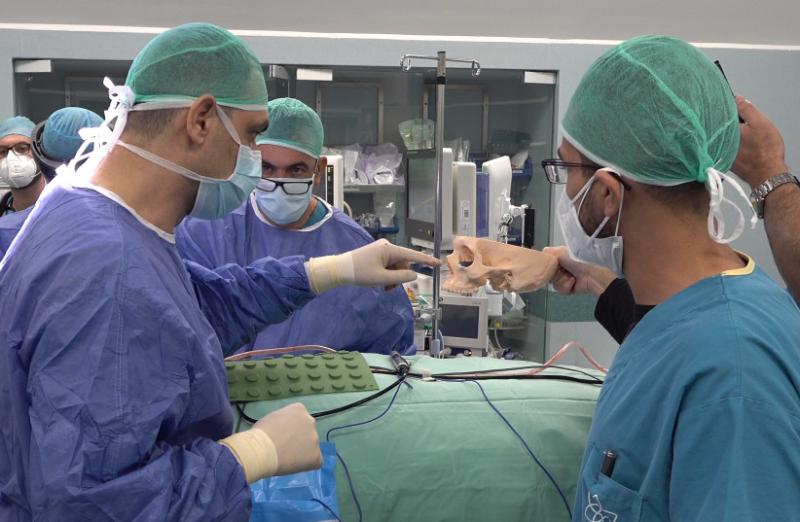Surgeons at the Israeli Galilee Medical Center (GMC) have developed a novel 3D printing and Augmented Reality (AR)-based technique for treating eye socket fracture patients.
In what’s believed to be a world’s first, the clinicians fabricated a metal implant for a face injury sufferer, then used Microsoft HoloLens glasses to accurately place it within their skull. The procedure proved to be both rapid and precise, paving the way for improved patient outcomes, and reducing the need for follow-up surgeries.
“Utilizing a 3D printer and AR resulted in both a particularly accurate execution of the operation, and a significant reduction in time,” Professor Samer Srouji, who led the procedure, told The Jersualem Post. “This technology will contribute to improved clinical outcomes and reduce repeated imaging and surgeries.”
The novel AR-based approach
Utilizing additive manufacturing to create customizable facial implants is, in itself, not a novel concept. Technicians at the UK’s NHS have deployed 3D printing within facial reconstruction for at least four years, while scientists at Texas A&M University have trialled stem cell-based implants that better encourage cranial regeneration.
Similarly, the HoloLens has been around since 2016, and developers such as Trimble have created software for the device that provide it with 3D modelling capabilities. The technologies are therefore not particularly new, but in combining them, the GMC doctors have uncovered a method of using modelling during the procedure.
The clinicians’ innovation was necessitated by the arrival of a 31 year-old man on their ward, who had sustained a fractured left eye socket. In order to treat the patient without impairing the aesthetics of his eyes, the doctors chose to work with partners at the Sheba Medical Center (SMC), and trial their innovative new surgery.

3D printing and surgical success
Before the procedure, the surgeons conducted CT scans of the patient, and used them to reconstruct the shape of the floor of his eye socket. This process allowed the doctors to build a 3D model of the skull, to ‘project’ the healthy side onto the damaged bone, and ultimately to accurately 3D print a customized titanium graft.
During the operation, one of the doctors wore the AR glasses, which were connected to 3D Systems’ D2P software containing both a model of the patients’ skull, and the metal plate. Subsequently, through the HoloLens, the surgeon was able to place the 3D model over the man’s head, and use it as a virtual guide in real-time.
Leveraging their holographic approach, the GMC team were able to reduce the time required for surgery down to just an hour and a half. Additionally, after the patient had been allowed to recover, further CT scans were conducted which showed that the transplant had been conducted optimally, and he was eventually discharged.
According to 3D Systems’ Executive VP of Healthcare Solutions Meno Ellis, the firm’s program was vital to the overall success of the surgeons’ innovative procedure. “The extended reality capability offered by our D2P software allows clinicians to create a 3D model of the patient’s anatomy and a treatment plan,” said Ellis.
“The orbital floor prosthesis used to reconstruct the patient was designed in 3D Systems’ Geomagic Freeform environment for patient-specific applications,” he added. “3D Systems is proud to support the forefront of surgical care through the power of additive manufacturing solutions to improve patient outcomes.”
For Srouji, the project’s success is down to the continued development of the GMC’s 3D Point of Care unit. Despite the ongoing impact of COVID-19, the GMC and SMC have continued to experiment with 3D technologies there, and both have committed to experimenting within new types of surgeries in the years ahead.
Advances in additive bone materials
Given that 3D printing is now often deployed within surgical applications, many scientists have turned their attention to creating more biocompatible implants that better help patients to heal.
Scientists from the Skolovo Institute of Science and Technology (Skoltech), for instance, have developed a novel method of 3D printing personalized ceramic bone grafts. The team’s simulation-based approach has yielded designs with larger pores, potentially enabling them to be easily fused with organic tissues.
Researchers from the Dutch Delft University of Technology, meanwhile, have found that 3D printed biodegradable magnesium scaffolds could be used to treat certain critical bone defects. The biomaterials were found to be capable of degrading naturally inside the body, while stimulating bone regeneration at the same time.
Elsewhere, a team from the Animal Health Trust (AHT) and University of East Anglia (UEA) have developed 3D printed scaffolds to support bone regeneration in horses. By injecting stem cells into their additive devices, the scientists were able to create novel osteoblasts, that could be used within veterinary fracture repair surgeries.
To stay up to date with the latest 3D printing news, don’t forget to subscribe to the 3D Printing Industry newsletter or follow us on Twitter or liking our page on Facebook.
Are you looking for a job in the additive manufacturing industry? Visit 3D Printing Jobs for a selection of roles in the industry.
Featured image shows the Israeli doctors preparing to conduct cranial surgery using their new AR -based technique. Photo via the Galilee Medical Center.



